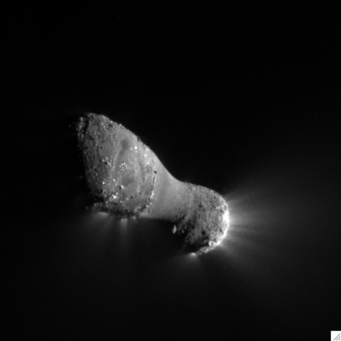Did comets bring water to Earth?
Observations of Hartley 2 have revealed the first comet with water similar to that on our home planet
Not only the impacts of asteroids, but also comets may have provided Earth with large parts of its water. This is a result of new measurements performed by ESA's space observatory Herschel that were led by scientists from the Max Planck Institute for Solar System Research (MPS) in Germany. The researchers were able to identify 103P/Hartley 2 as the first comet who’s water is characterized by a similar ratio of deuterium to hydrogen as Earth's water. Approximately one year ago, Hartley 2 had passed Earth in a distance of only 18 million kilometers thus allowing for the highly sensitive measurements.

Even though it sounds like a paradox, water is an immigrant on our blue planet. In the early days of our planetary system, Earth was so hot, that all volatiles such as water evaporated. Only the outer regions of our solar system beyond the orbit of Mars remained rich in water. From there, it is believed to have returned to Earth approximately 3.9 billion years ago - „on board“ of asteroids, as scientists have assumed until now.
„Current theories came to the result that less than ten percent of Earth's water originated from comets“, Dr. Paul Hartogh from MPS, who led the new study, explains. „Now for the first time, our results imply, that comets may have played a much more important role“, Dr. Miriam Rengel from MPS adds.
The most important clue in the search for the cosmic water supplier is deuterium, also called heavy hydrogen, which contains an additional neutron in its nucleus. On Earth, the ratio of deuterium to hydrogen is approximately 1:6400. „The small bodies that brought water to Earth should have a similar ratio of these two isotopes“, explains Dr. Miguel de Val-Borro from MPS.
Until now, this held true mainly for asteroids from the outer rim of the so-called asteroid belt close to Jupiter's orbit. The six comets for which conclusions concerning this ratio have been possible so far, are likely much richer in deuterium. All these comets are believed to have originated in the vicinity of the large gas planets Jupiter, Saturn, Uranus, and Neptune.
Hartley 2, however, is different. Scientists believe that its cosmic home lies in the Kuiper belt, a region on the outer limits of our solar system. In October and November 2010, Hartley 2 passed Earth as closely as never before since its discovery. During this encounter, also the instruments on board the space observatory Herschel were therefore aimed at the comet. With the help of exact observations of its coma – the sheath of gas and dust surrounding comets, when they come close to the Sun – the researchers hoped to determine the deuterium-to-hydrogen ratio.
